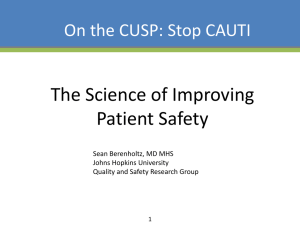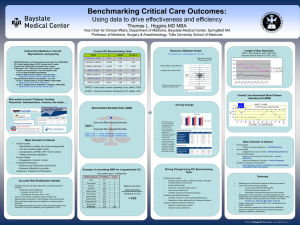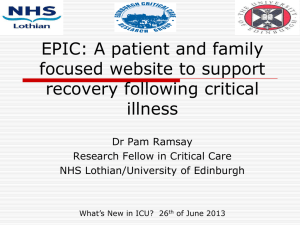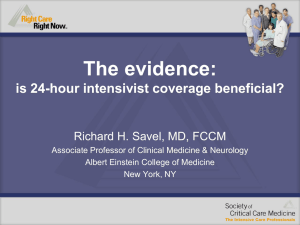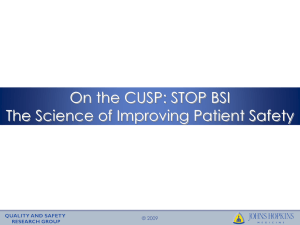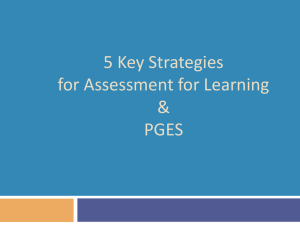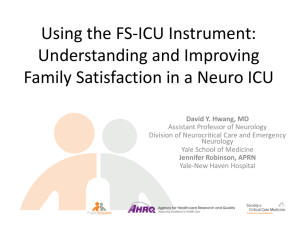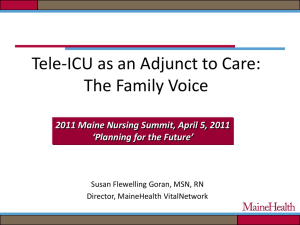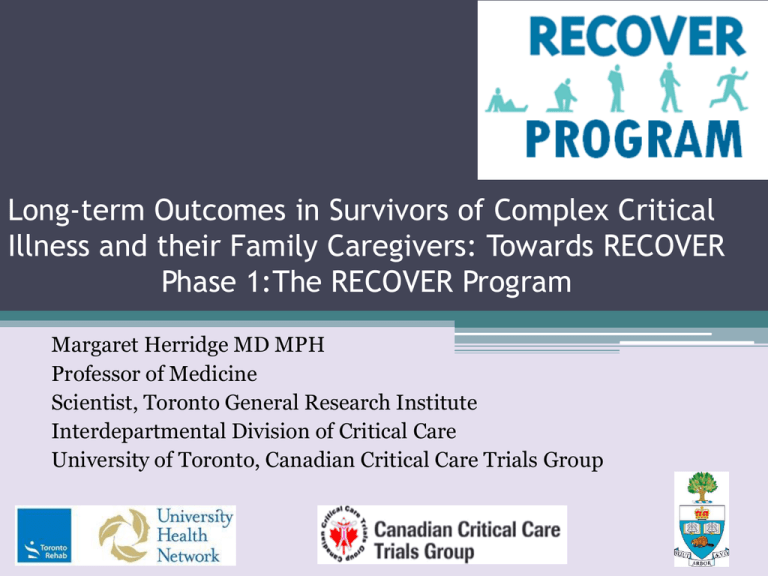
Long-term Outcomes in Survivors of Complex Critical
Illness and their Family Caregivers: Towards RECOVER
Phase 1:The RECOVER Program
Margaret Herridge MD MPH
Professor of Medicine
Scientist, Toronto General Research Institute
Interdepartmental Division of Critical Care
University of Toronto, Canadian Critical Care Trials Group
Overview
•
•
•
•
Spectrum of Disability
Continuum of Weakness
Cognitive Dysfunction and Mood Disorders
RECOVER and risk stratification to optimize
rehabilitation
Evidence of diaphragmatic atrophy and increased proteolysis
at 18 hours of mechanical ventilation
De Jonghe, B. et al. JAMA 2002;288:2859-2867
Ali N et al. AJRCCM 2008; 178:261-268
Herridge et al. N Engl J Med 2003; 348:683-93.
•All biopsies were abnormal (6-24 months after ICU discharge)
•No patients were exposed to steroids or paralytics
•Most common abnormality was type II fiber atrophy
•Manifested as narrow angulated fibers; myofibers were reduced to
clumps of myonuclei
•Myofibrillary disarray on EM
•Changes not exclusively attributable to disuse atrophy
Angel et al. 2007 Can J Neurol Sci 34: 427-432
Five-Year Outcomes in ARDS
Herridge et al. NEJM 2011; 364: 1293304
Persistent exercise limitation
and reduction in Physical QOL
at 5-years after ICU discharge
Heterotopic Ossification
Alopecia
Tracheal stenosis
Cosmesis- Scars from CVC, Art line, CT, drain sites
Nerve and Muscle
Brain
Hearing Loss
Bronchiectasis
Pulmonary
fibrosis
frozen joints
contractures
Renal Impairment
Taste changes
Weakness
Mental Health & Cognition
striae
Ischemic digits
Disability after Critical Illness
1 & 2 Year Cognitive Outcomes
Percent with Deficits
100
Hospital DC
1 Year
2 Years
80
60
40
20
0
Processing
Speed
Memory
Executive
Attention
IQ
Hopkins et al. AJRCCM 1999; 160:50
Hopkins et al. J Int Neuropsych Assoc 2003; 9:584
Hopkins et al. AJRCCM 1999; 160:50
Hopkins et al. J Int Neuropsych Assoc 2003;9:584
• Enrolment in a conservative fluid-management strategy was associated with
cognitive impairment
• Lower partial pressure of oxygen was associated with cognitive and psychiatric
impairment
• Hypoglycemia was associated with mood disorders
Am J Respir Crit Care Med 2012; 185:1307-13
Pandharipande et al. NEJM 2013
•Sepsis survivors had a reduction in verbal learning and memory
• Reduction in left hippocampal volume
•Increase in low frequency EEG activity consistent with brain dysfunction
•No clinical difference in HRQOL, psychological dysfunction, mood disorders
Brain Atrophy
Ischemic Changes
Suchyta et al. Brain Imaging and Behavior 4:22-34, 2010
Risk Factors for Cognitive Dysfunction
•
•
•
•
•
•
•
Duration of Delirium
Blood Glucose Dysregulation
Conservative Fluid Management
Hypoxia
Hypotension
Corticosteroids
Sedatives, Analgesics
Mikkelsen et al. AJRCCM 2012; 185:1307-15
Girard et al. Crit Care Med 2010;38: 1513-1520
Hopkins et al. Brain Inj 2010; Sept 21 Epub
Hopkins et al. AJRCCM 1999; 160:50-56
Hopkins et al. AJRCCM 2005; 171:340-347
Rothenhausler et al. Gen Hosp Psychiatry 2001; 23: 90-96
Depression
• Prevalence 17-43%
• May decrease or stay the same over time ( Hopkins
2010; Adhikari 2011)
• Risks include: alcohol dependence, female gender,
younger age, cognitive dysfunction, hypoglycemia,
severity of illness measures, mean ICU benzodiazepine
dose
• Associated with ability to return to work
Davydow et al. Psychosom Med 2008; 70:512-9
Adhikari et al. Chest 2009;135: 678-687
Hopkins et al. Gen Hosp Psychiatry 2010; 32: 147-55
Dowdy et al. Crit Care Med 2009; 37: 1702-7
Dowdy et al. Crit Care Med 2008; 36:2726-33
Douglas et al. J Crit Care 2010; 25: 364
Adhikari et al. Chest 2011; 140: 1484-93
Persecutory Delusions/PTSD
Griffiths and Jones BMJ 1999; 319:427-9.
Post Traumatic Stress Disorder
• Prevalence 21-35%
• Risk factors include benzodiazepine exposure, delusional
memory, female sex, younger age, physical restraint in
the ICU, low serum cortisol, not receiving
corticosteroids, Vent days, ICU LOS
• Endogenous personality traits: pessimism
Jones et al. Critical Care 2010; 14(5): R168
Myhren et al. Crit Care 2010 ;14: R14
Davydow Crit Care 2010; 14: 125
Kapfhammer et al. Am J Psychiatry 2004; 161: 45-52
Jones, Griffiths et al. Crit Care Med 2001; 29: 573-80
Stoll et al. Int Care Med 1999; 25: 697-704
Schelling et al. Crit Care Med 1998; 26: 651-9
Caregiver Burden
CCM 2008; 36: 1722-1728
PTSD symptoms consistent with a moderate to major risk of
PTSD were found in 33% of family members.
Azoulay et al. AJRCCM 2005; 17: 987-994
Jones et al. Int Care Med 2004; 30: 456-460
Caregiver depression risk was 34%, 31% and 23% at 2, 6, 12 months
Lifestyle disruption and employment reduction were common.
Compromised HRQOL similar to caregivers of stroke/dementia
Depressive
symptomatology associated with depression in ARDS survivors
.
Van Pelt et al. AJRCCM 2007; 175: 167-173
Cameron et al. Crit Care Med 2006;34:26-33
• Higher re-experiencing scores on PTSD measures were associated with
higher arousal ratings of negative pictures and reduced amygdala, thalamus
and globus pallidus volumes.
• Chronic re-experiencing of traumatic events may result in structural changes
associated with autonomic arousal and acquisition of conditioned fear
Caregiving as a Risk Factor for Mortality: The Caregiver Health Effects Study
JAMA. 1999;282(23):2215-2219
• UHN/TRI Lead Canadian Multi-Centre Interprofessional
Program of Outcomes and Rehabilitation in Survivors and
Family Caregivers after Critical Illness- Program initiated in
2007
• Co-Principal Investigators- Margaret Herridge MD MPH and
Jill Cameron PhD
24
The RECOVER Research Program consists of Four Phases:
•Phase I: Towards RECOVER
•Phase II: RECOVER development and pilot testing
•Phase III: RECOVER randomized controlled trial
•Phase IV: RECOVER KT and Health Policy Change
25
Patient Outcomes
(Quantitative)
FIM Total Score
Total Functional Independence Measure
scores at 7-days, 3, 6, and 12-months post
ICU discharge
6MWT (% of predicted)
Distance walked in 6 minutes (percent of
predicted values) at 7-days, 3, 6, and 12months post ICU discharge
26
Patient Outcomes
(Quantitative)
SF-36 Physical Component Score
SF-36v2 Physical Component Scores at 3months, 6-months and 12-months post ICU
discharge
MRC Total Score
Total MRC scores at 3-months, 6-months and
12-months post ICU discharge
27
Caregiver Outcomes
(Quantitative)
Care-giving Impact Scale
Care-giving impact scale at 7 day, 3-months,
6-months and 12-months post ICU discharge
Centre for Epidemiological Studies
Depression Scale
Centre for Epidemiological Studies
Depression (CESD) at 7 day, 3-months,
6-months and 12-months post ICU discharge
≥16 considered at risk for symptoms of
depression
28
Etiologically Neutral Clinical Phenotypes
• Different clinical phenotypes for outcome and possibly muscle and nerve
correlates for this
• Spectrum determined by age, burden of comorbid disease, ICU LOS
• Younger group- more intensive rehab, assist with return to work, children
• Middle-aged group with comorbidities- Some rehab, OT, planning for
‘new normal’
• Older patients- goals of care, disposition, complex medical management,
OT/social work to optimize supports
Challenges and Opportunities
There is a spectrum of disability across clinical
phenotypes both in terms of muscle
injury/atrophy/dysfunction/ other morbidities and also
repair and clinical recovery
We need to understand the basic science correlates of
muscle, brain and nerve injury
Different risk groups will require very different
interventions and these need to be constructed and tested
The family caregiver needs support and is a key risk
modifier of outcome

